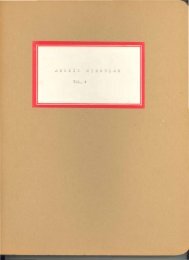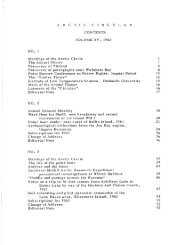Volume 8, 1955 - The Arctic Circle - Home
Volume 8, 1955 - The Arctic Circle - Home
Volume 8, 1955 - The Arctic Circle - Home
- No tags were found...
You also want an ePaper? Increase the reach of your titles
YUMPU automatically turns print PDFs into web optimized ePapers that Google loves.
VOL. VIII NO.2 THE ARCTIC CIRCULAR 20the outstanding work of Jenness, Birket-Smith, Boas, Rasmussen,Hawkes, and Turner, have been historical and descriptive, ratherthan functional and comprehensive, and were made at a time whenthe Eskimo were relatively free from outside influences. It isunfortunate that today. when the Canadian Government is startinga program of help for the Eskimo, we do not have a single exhaustivestudy of a community made with the techniques of modern culturalanthropology. Such a study would give a detailed insight into theway in which a contemporary Eskimo group is organized. We do notyet know how the internal forces which integrate the different facetsof such culture into a homogeneous whole operate, and how theprocess of disruption works whenever external influences are notintegrated into the original culture. 1<strong>The</strong> main purpose of my visit to the Belcher Islands inthe Bummer of 1954, which was made possible by a scholarship fromthe McGill University-<strong>Arctic</strong> Institute Carnegie Program, was tofind Bome of the answers to these problems. I planned this "communitystudy" aB the first of a series, which would range from the study of arather simple, well-integrated group to that of more complex groups.highly disturbed by intense contact with the white man. Each groupwas to be chosen as characteristic of some definite geographicalenvironment and historical development. It was hoped that thetonclusions reached in this work would give a fairly comprehensiveidea of the direction of the socio-cultura1 evolution of the CanadianEskimo. Furthermore, that hypotheses formulated in the courseof these investigations would be of assistance to the administration1n anticipating the numerous implications of a planned change.I am interested in the Eskimo for thems elves, and notmerely as a group of people on which to test hypotheses for the sakeof anthropological theory, therefore I think that the community studiesshould have a historical background, provided by interviews andarchaeological excavations. whenever such information is notreadily available.•I1. Some work along these lines has been done by J. J. Honigmann,who published a paper on "Intercultural relations at Great WhaleRiver", Amer. Anthropologist, Vol. 54 (1952) pp. 510-22. InAlaska G. D. Berreman has made a detailed study of Nikolski in1952, but his M.A. thesis for the University of Oregon, "A contempol'al'Ystudy of Nikolski, an Aleutian village", has not yet been published.












